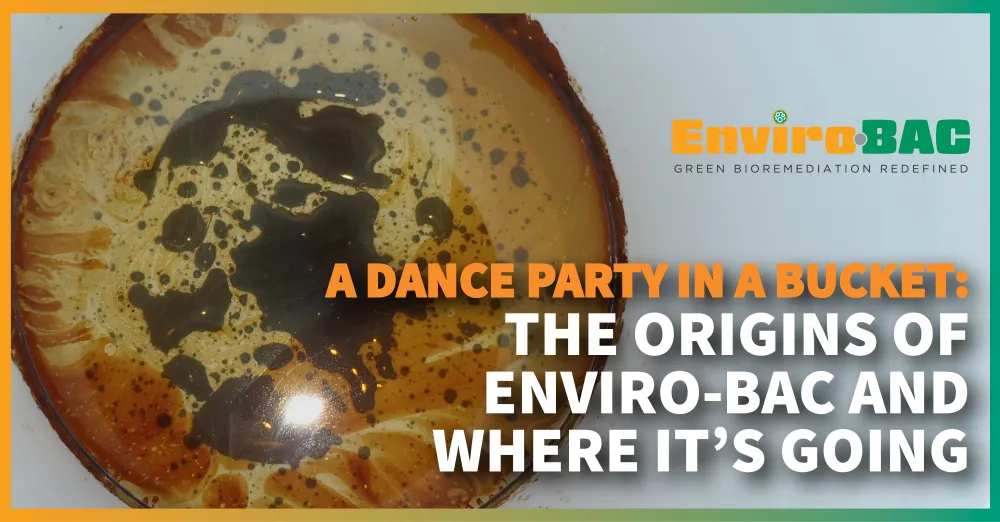A Dance Party in a Bucket: The Origins of Enviro-BAC and Where It’s Going
August 25th, 2025

Depending on who you ask, the story of Enviro-BAC began with either a spark of scientific curiosity or a beer at a football game. Either way, Jay Lawson and Jeff Ballsieper, HRP’s Directors of Operations for North Carolina and Texas respectively, remember the moment when a casual conversation shifted into something more.
Neither Jay nor Jeff are strangers to the traditional remediation techniques and technologies. They were used to the same old trailer-mounted mobile system sitting on-site for days or even months, slowly extracting groundwater and soil vapor in what’s known as dual-phase extraction. It worked, but only to a point. As sites got cleaner, they began to ask: Can we ever get a site completely clean using just this method?
“The short answer was yes, with enough time,” says Jeff.
“But we were finding that residual 10% of groundwater contamination persisted. We were spending a lot of money and effort to get that last 5-10%. That's why we started dabbling with bacteria as the solution for remediating that last 5-10% without needing a surfactant. But then Jay had that beer at a football game and the discussion turned to What if a biological product could spin off a biosurfactant on its own?"
Jay and Jeff became interested in the idea of not technically adding a surfactant, but encouraging a biological process that created one. The next question was: if we’re going to introduce these little critters into the subsurface, what’s the downside?
To find out, they ran a bench-top test. Petroleum-contaminated groundwater in a jar, treated with their bacteria. Thirty days later, petroleum concentrations had dropped by 99.7%. A success that changed their focus.
“We started leaning into the idea of these bacteria as petroleum degraders,” Jay says.
And that’s sort of how Enviro-BAC was born – an effort to bring a natural and sustainable product to the bioremediation space. Made of naturally occurring, non-pathogenic Bacillus bacteria spores, the product works in both oxygen-rich and oxygen-poor environments. It’s spray-dried for easy use in soil, water, spills, borings, and groundwater injection. And crucially, it’s been vetted and approved by regulators across the U.S.
“Since we’ve been at HRP, we’ve been introduced to material coming from a manufactured gas plant (MGP). The product is really sticky and gets all over well screen, tools, and pumps. It’s hard to get it out of the ground. On a whim, we threw some Enviro-BAC in a bucket with water and some heavy petroleum, and our bacteria started having a dance party,” says Jeff.
Within days, the petroleum stopped clinging to the bucket and the stirring stick. Over time, the product visibly shrank—from nickel-sized patches to a mere speck.
“It wasn’t something we were expecting,” says Jay. “We knew in working with manufacturers that the bacteria we started with had the potential to be petroleum degraders. We just didn’t expect the extent of what we saw in that initial bench top study of those concentrations dropping like a rock. That changed our mindset somewhat. From a degradation standpoint, we knew we’d be able to get a lot done.”
Today, HRP is exploring what’s next.
“We’re asking folks to free their minds,” Jay says. “Think about where this could work, not just where it’s always been done, and to think of it as another tool in the tool box.”
Enviro-BAC was recently deployed at a fuel oil–contaminated site in New York—where the material is so viscous it usually requires heat just to move it, an energy-intensive process. The goal: inject the bacteria, observe how they alter the chemistry and behavior of the subsurface oil, and pair that biological action with mechanical extraction methods like pumps and vacuums.
Meanwhile, testing is underway to explore Enviro-BAC’s potential to tackle some of today’s most pressing environmental concerns, including PFAS (“forever chemicals”), microplastics, and wastewater. By targeting contaminant breakdown and reducing solids in wastewater lagoons, Enviro-BAC could help ease the burden on public treatment systems while cutting down on costly chemical processes.
As testing expands, one thing is clear: these tiny bacteria may play a big role in the future of sustainable remediation—and they’re just getting started.







